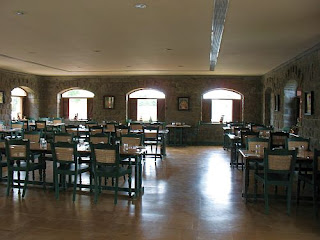In our upcoming Arunachala Grace Newsletter, we have a narrative about The Ribhu Gita, a spiritual text extensively used by Bhagavan Sri Ramana Maharshi. It was one of the first books he read after self-realization after he came to Arunachala, with a message that clearly accorded with what he had realized within himself. During his life it was recited at Ramanasramam. It is still read at Ramanasramam today.
 HWL Poonja studyingThe Ribhu Gita
HWL Poonja studyingThe Ribhu Gita
Both the Sanskrit and Tamil versions have been translated into English in complete translations. This was done by Dr. H. Ramamoorthy, a Sanskrit and Tamil scholar, and Nome, a Self-Realized sage in the United States of America, who in 1974 realized the Truth revealed by Sri Ramana Maharshi and the Ribhu Gita. Both translations, The Ribhu Gita and The Song of Ribhu (the Sanskrit and Tamil versions of the text) have been printed by the Society of Abidance in Truth (SAT) and are available from their website.
 Nome
Nome
Nome was born on January 23, 1955 in Long Island, New York and spent most of his childhood in New Jersey. Though not from a religiously oriented family, Nome as a child had memories and a vivid familiarity with places, images, and words that he came to know later as associated with Sri Ramana Maharshi and Advaita Vedanta. His first spiritual experience came at age 16 — without previous spiritual questing (in this life), one day in a park. It was nirvikalpa samadhi. Sri Ramana Maharshi refers to nirvikalpa samadhi as complete absorption in the Self with resultant oblivion to the manifested world, as a state of blissful trance but not permanent, like a bucket of water lowered into a well
After Nome’s 17th birthday, before completing high school, he left his family without telling them he was going. When asked by a friend why he was going, he said, “To attain Self-Realization.” He got an airplane ticket and flew to San Francisco. In San Francisco he met Swami Swanandashram, who introduced him to Sanatana Dharma (the Eternal Teaching). Nome kept the focus of his life within. He found wisdom in such books as Talks with Ramana Maharshi, the Avadhuta Gita, the Astavakra Gita and Sankara works such as Atma Bodha.
He lived in a renounced fashion, meditating, intensely practicing Atma Vichara (Self inquiry). During this period of practice, Nome saw that “Whoever we are, Bliss is within, and can no more be apart from us than we can be separated from our own existence.” Now, how to turn the mind inward, and to turn it inward steadily? The answer was the Maharshi’s steady inquiry, revealing the Bliss of the Self. The search for happiness is really the search for the Self, which is Reality. He placed himself in Sri Bhagavan’s hands, feeling that when the heart’s consecration is made, Grace is always present.
In 1974, at 19 years of age, waiting in the office of an oral surgeon, meditating on a small Ramana pamphlet Self Realization, Nome realized finally and completely that the notion of “I” does not refer to any actually existent ego entity, and is itself unreal. This “I” does not come from the real Self, does not come from “anything else,” and is not self-generated. This was the revelation of Truth, without these words or ideas. Everything objective disappeared, never to return. This is what Ramana referred to as Sahaja Samadhi.
In 1978, after four years spent mostly in silence, Nome started answering questions of sincere aspirants, first in a house in San Bruno, CA, then Boulder Creek, and finally Santa Cruz. Around Nome a group of spiritual seekers formed, and was first called “The Avadhut Ashram.” Satsang was held in Santa Cruz and San Francisco.
Since that time, In addition to giving satsang at SAT, Nome continues to write, translate and publish spiritual texts that support the practitioner of Self-inquiry and Advaita Vedanta. Nome started collaborating in 1988 with Dr. H Ramamoorthy, a Sanskrit and Tamil scholar, to translate original Advaita Vedanta scriptures into English. Together they translated more than 20 Advaita Vedanta texts. Of these, more than half have been published to date. The translation work proceeded from 1988 to the 2001 passing of Dr. Ramamoorthy. Nome now continues to translate and publish Sanskrit texts, including the completion of manuscripts which were started in collaboration with Dr. Ramamoorthy.
Nome has journeyed to India several times, staying at Sri Ramanasramam, Tiruvannamalai and The Ramana Centre for Learning in Bangalore, India. Nome gives satsang at SAT (Society of Abidance in Truth, Santa Cruz, CA). He reveals the non-dual Advaita Vedanta of Sri Bhagavan Ramana Maharshi and Adi Sankara and the practice of Self-inquiry (Atma Vichara).
To find out more about the Society of Abidance of Truth and to order their books please go to their website.
[With thanks to Richard Clarke, Sarasvati and others]
 I actually liked the Temple better before the 'modernization' but suppose after a few years of sun and weathering, the statues will lose that 'bright lick of paint,' look and become more interesting.
I actually liked the Temple better before the 'modernization' but suppose after a few years of sun and weathering, the statues will lose that 'bright lick of paint,' look and become more interesting. Probably because the Temple is off the beaten track, lots of pilgrims and visitors miss out on the experience of visiting the Pachaiamman Koil. But its definitely one of the most interesting Temples at Arunachala.
Probably because the Temple is off the beaten track, lots of pilgrims and visitors miss out on the experience of visiting the Pachaiamman Koil. But its definitely one of the most interesting Temples at Arunachala.














































